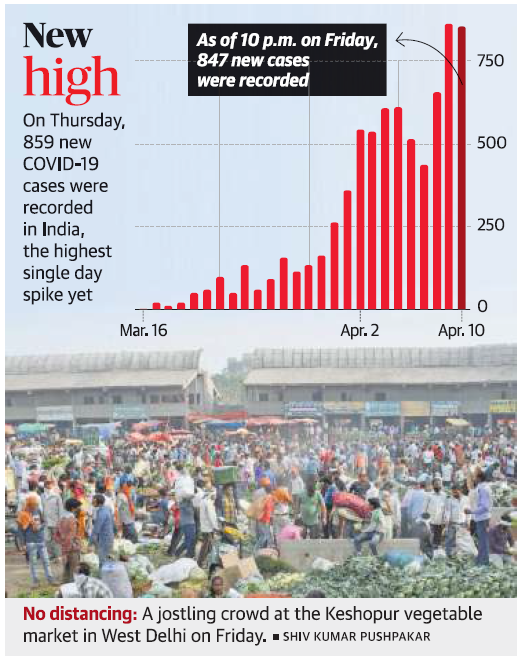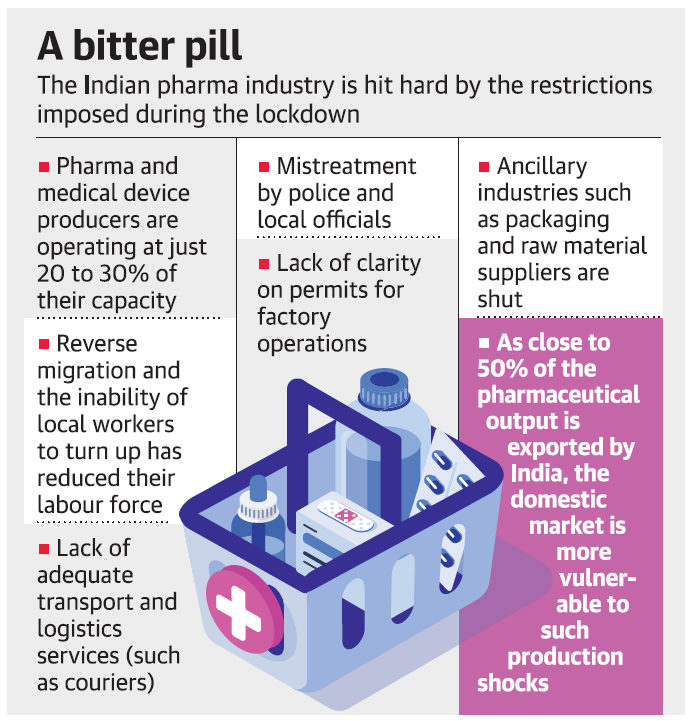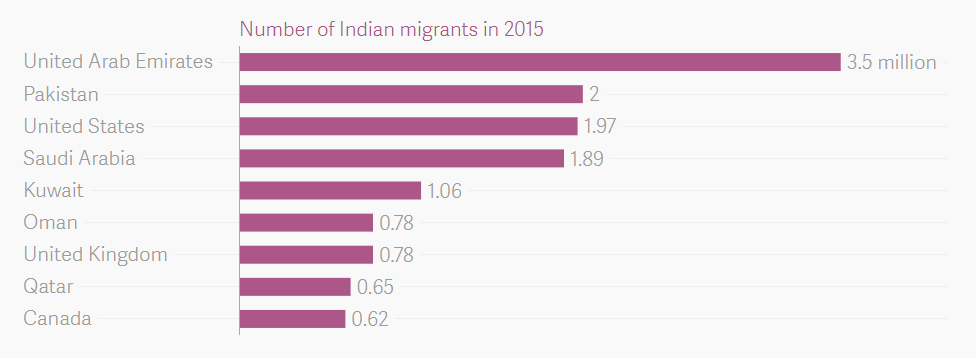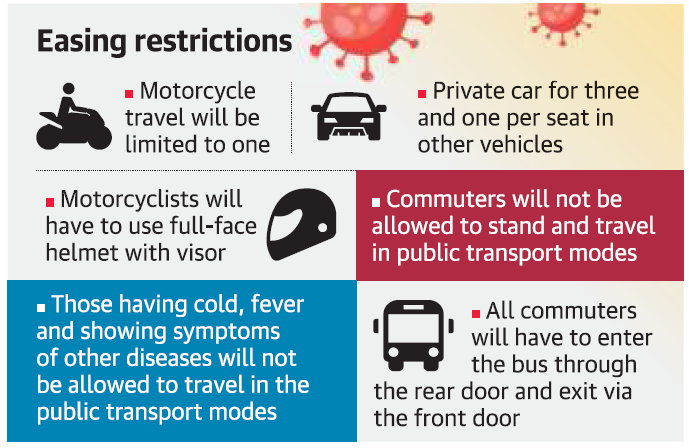Contents:
- No evidence of community transmission, Scarcity of drugs, devices imminent
- Ready to fly stranded Indians: UAE
- Red army keeps virus at bay in Northeast
- Bhilwara breaks virus transmission chain
- Choked supply lines to be cleared, Tougher norms likely for public transportation
- India well-equipped, has enough stock of HCQ
- Bank credit shot up just before lockdown
- Moratorium on repayment puts NBFCs in a spot
- Post-pandemic period will see turnaround in job market
NO EVIDENCE OF COMMUNITY TRANSMISSION, SCARCITY OF DRUGS, DEVICES IMMINENT
Focus: GS-III Disaster Management
Why in news?
- The Union Health Ministry on Friday denied evidence of community transmission (CT) of COVID-19 while reporting at least 700 new cases since 9th April 2020.
- A countrywide shortage of medicines and medical devices is likely in the coming weeks, the Department of Pharmaceuticals has warned the Home Ministry.
Denial of Community transmission

- There was evidence for community transmission — or instances of coronavirus (COVID-19) in patients who had no established contact with someone who had picked up the disease from abroad — from as early as March 22, suggests a research study in the Indian Journal of Medical Research, authored by several ICMR scientists.
- The ICMR’s official position continues to be that there is no evidence for community transmission.
- The Ministry’s response follows an Indian Council of Medical Research (ICMR) report.
- The World Health Organisation describes Community Transmission as when there are large clusters of outbreaks when it is no longer possible to trace the original source of an infection.
- Over the last few weeks, there have been reports from several States of people testing positive but who were unable to explain the possible source of the infection.
- However, the Health Ministry has consistently maintained that this was not evidence for CT.
Concern of Scarcity of Drugs and Devices

- Department of Pharmaceuticals has urged the Home Ministry to take immediate steps to help drug makers resume production under the current lockdown as a countrywide shortage of medicines and medical devices is likely in the coming weeks.
- Drug and medical device makers are functioning on an average, at only 20%-30% capacity during the lockdown.
- If the production does not reach the pre-lockdown level soon, it could lead to shortages of medicines and medical devices in the coming weeks.
- Half of India’s output of pharmaceuticals is exported as global markets offer better prices
- Production units engaged in making essential commodities, including medicines, vaccines, masks and their ancillaries had been exempted from the restrictions imposed as per the three-week national lockdown announced by Prime Minister Narendra Modi on March 24.
Requests by the Department of Pharmaceuticals
- Dept. of Pharmaceuticals urged the Home Ministry to allow the pharma industry to ‘ferry back their contractual workers from their native places’ and make courier services ‘fully functional’ in metro cities as well as Tier 1 and Tier 2 cities.
- State and district administrations need to be sensitised and nudged to be proactive to fulfil the need for pharma units to function fully.
- There is a dire need to not only address the apprehensions of the pharmaceutical distribution related drivers but also to motivate/incentivise them (with insurance, etc.).
READY TO FLY STRANDED INDIANS: UAE
Focus: GS-II International Relations
Why in news?
Responding to India’s concerns, the United Arab Emirates has offered to fly stranded Indian nationals who want to return home in view of the COVID-19 pandemic.
The government of UAE has decided to help all countries fly their citizens home after the completion of the necessary medical tests.
Details
- UAE has reached out to all foreign governments to repatriate their nationals including testing them before they leave and if found positive to treat them here.
- A note verbale to all embassies was sent seeking the help of all governments.
- The repatriation offer would be available only to those citizens unaffected by the viral outbreak.
- Kerala was worried about the safety and well-being of its diaspora in the Gulf, the Chief Minister said, seeking Central intervention.
- New Delhi has said there are at least 25,000 Indian citizens consisting of travellers, students and stranded tourists in various parts of the globe who want to return home.
- It is believed that a substantial number of these citizens are in Dubai and Abu Dhabi as these are two prominent aviation hubs that serve India.
Indian Diaspora report as of September 2019
- The count of the Indian disapora has increased 10% from 15.9 million in 2015, making it the largest in the world, according to the UN’s International Migrant Stock 2019 released on September 2019.
- It now comprises 6.4% of the total global migrant population.
- In 1990, India was behind Russia and Afghanistan as a source of international migrants at 6.6 million with Russia sending 12.7 million abroad and Afghanistan 6.8 million.
- In 2019, Russia fell to the fourth position behind Indian, Mexico and China with 10.5 million migrants.
- The United Arab Emirates (UAE) was the top destination of Indian migrants followed by the US, Saudi Arabia, Pakistan and Oman, as per the data set compiled by the UN Department of Economic and Social Affairs Division.

RED ARMY KEEPS VIRUS AT BAY IN NORTHEAST
Focus: GS-I Indian Society
Why in news?
A ‘red army’ of wise old men and women are helping villages across some hill States in the northeast keep the novel coronavirus away.
‘Red Army’ of the Northeast
- Gaon buras (male villager elder) and Gaon buris (female village elder) — usually referred to as GBs — “formed a shield” between the villages and the virus.
- The village elders across the States are distinguished by their red coats provided by the government, which also pays them a stipend of ₹1,500 per month.
- The villagers look up to the elders in times of crisis as well as happiness. They consider it their duty to ensure their safety and liaise with the government agencies for guidelines and in maintaining order.
- During epidemics and disasters, GBs put their heads together to decide what is best for the villagers and share the responsibilities.
- Assisting the GBs in Nagaland are the dobashi, the custodians of Naga customary laws who also wear red coats.
- They have been salaried government employees since 1842 when the British appointed the first dobashis for interpreting Naga dialects into Assamese or Hindi.
- Arunachal Home Minister said the importance of village veterans was evident from the inclusion of the powers of the GBs in the Constitution and they are indispensable.
BHILWARA BREAKS VIRUS TRANSMISSION CHAIN
Focus: GS-III Disaster Management
Why in news?
The “ruthless containment” model adopted in Bhilwara, which emerged last month as the worst-affected district in Rajasthan, has succeeded in breaking the chain of novel Coronavirus transmission.
Details
- Since April 3, when an aggressive 11-day-long “all-down curfew” started with even essential services being curtailed, only two new cases have been reported in the city of 4 lakh people.
- Teams of health workers have screened a population of 24 lakh in the entire district and conducted contact tracing of COVID-19 patients on a war-footing.
Meticulous strategies
- The containment model involved some meticulous strategies adopted in several phases, including isolation of the district with its borders being sealed, screening in the city and in rural areas, and sending the people showing symptoms to home quarantine and the confirmed patients to isolation wards.
- This was followed by a rigorous monitoring in the district’s villages.
- Significantly, the total lockdown in Bhilwara started on March 20, shortly after the health authorities detected the first positive case in a private hospital and four days before Prime Minister Narendra Modi declared the three-week nationwide lockdown.
- The aggressive screening process was taken up during the lockdown.
- The district administration also acquired hotels, resorts, hostels and dharamshalas in the town to arrange 1,500 quarantine beds and 14,400 normal beds to meet an emergency situation.
- During the ongoing “all-down curfew”, there is no relaxation of any type and the essential items are being delivered to the city residents at their doorstep.
CHOKED SUPPLY LINES TO BE CLEARED, TOUGHER NORMS LIKELY FOR PUBLIC TRANSPORTATION
Focus: GS-III Indian Economy
Why in news?
- Stoppered supply lines with trucks waiting on highways, the ongoing harvest season and procurement of food grains in various parts of the country are some of the issues that will inform the kind of lockdown the country will continue to have post April 14.
- Motor Vehicles Department chalks out protocol for post-lockdown Kerala.
Smoothening the supply lines
- Government sources said that smoothening the supply lines that have still to be seamless and the harvest and procurement season have complicated the issue of the kind of lockdown to have.
- Harvesting is very important, as is procurement as there are standing crops and they need to be taken care of.
- Mandis etc., do not lend themselves to social distancing.
- Various micro plans are being considered for various States and an overall advisory on how to go about enforcing the behaviour required for the prevention of the spread of COVID-19 is likely to be sent out.
Tougher norms for Public Transportation in Kerala

- Restricting the number of persons travelling in cars, buses, and on bikes and increasing the working hours, five-day week, and odd-even system to restrict vehicles have been spelled out in a protocol chalked out for public transportation post-lockdown in the State.
- The protocol also calls for developing an app or a software to track the movement of inter-State rail and bus commuters.
- Motorcycle travel will be limited to one, private cars for three, and one per seat in other vehicles.
- Family members will be allowed in cars and motorcyclists will have to use full-face helmet with visor.
- Local bodies will have to take the lead in sanitising goods vehicles at the 19 check-posts of the MVD and issue guidelines to drivers.
INDIA WELL-EQUIPPED, HAS ENOUGH STOCK OF HCQ
Focus: GS-III Disaster Management
Why in news?
Were matters to deteriorate, India had enough infrastructure to tide over the crisis said the Health Minister at an online conference.
The Union government on 10th April asserted that India had “sufficient buffer” of the much in demand drug hydroxychloroquine (HCQ).
A Well-Equipped India
- India had multiple strategies in place to contain the pandemic. For more than 15 cases in a district, we have a ‘large outbreak’ strategy and for less than 15, a cluster containment strategy.
- Until now, India had largely relied on importing Personal Protective Equipment for health care workers. However, with rising local demand and shortages, the government had, via the Ministry of Textiles, authorised 39 manufacturers to make such equipment locally.
- From next week, 10 lakh PPEs are expected, as well as 48,000 additional ventilators, hence, India is unlikely to face an “unmanageable crisis”.
In demand Hydroxychloroquine
- Export of the drug to 13 countries including U.S., Germany, Canada, Brazil, Bahrain, Seychelles, Mauritius and the SAARC neighbouring countries had begun in India. Although the drug is ONLY BELIEVED but not clinically proven yet to treat COVID-19, it is in high demand.
- A lot of requests of HCQ are already there and taking into view the domestic stock and requirement and keeping sufficient buffer, a decision was taken by the Group of Ministers to release some of the surplus medicine for export purposes.
- The government’s move won it many expressions of gratitude from countries that received clearances for their medical supplies, which had been held up for weeks after the Directorate General of Foreign Trade banned them for export.
- Exports of HCQ and paracetamol were banned in the first week of April but the government overturned the ban on April 6, allowing the Ministry of External Affairs (MEA) and the Department of Pharmaceuticals to assess requests from various countries and clear their supply.
- Twenty-four other drugs that were put on a restricted list in March have been cleared for export as well.
Why is HCQ being Exported?
MEA officials said exports were being cleared for more than a dozen countries in three categories:
- Humanitarian aid,
- Aid to neighbouring SAARC countries,
- Commercial orders to countries such as the U.S. and Brazil, who have pushed the most for the release of HCQ orders for which their companies had made advance payments.
BANK CREDIT SHOT UP JUST BEFORE LOCKDOWN
Focus: GS-III Indian Economy
Why in news?
Bank loans grew by a whopping ₹2.31 lakh crore in the fortnight ended March 27, indicating robust loan demand just when a nationwide lockdown was imposed to contain the spread of COVID-19, according to the RBI.
This was probably the highest fortnightly loan growth recorded in financial year 2019-20.
Details
- The good thing is that banks have witnessed good traction in credit (term and working capital requirements) in the last seven days of the year ending March 31, 2020. It seems companies/corporates are preparing themselves for a surge in demand after the lockdown period.
- Latest data released by the Reserve Bank of India (RBI) showed, credit growth for the year ended March 27 was 6.1%, one of the lowest in many years.
- The central bank had also said that there were signs of growth picking up, in the monetary policy report released.
- Prior to the outbreak of COVID-19, the outlook for growth for 2020-21 was looking up. The COVID-19 pandemic has drastically altered this outlook.
MORATORIUM ON REPAYMENT PUTS NBFCS IN A SPOT
Focus: GS-III Indian Economy
Why in news?
Non-banking financial companies (NBFCs) may face a tough time following the Reserve Bank of India’s recent directive on providing a moratorium on repayment.
Why would NBFC face the heat?
- This is because though these entities are providing moratorium to their customers, they still have to continue repaying banks and other borrowers. NBFCs are highly dependent on banks for funding.
- NBFCs face a double whammy because they are offering moratorium to customers despite not getting one themselves from their lender-banks.
- That will put a significant pressure on the liquidity profiles of many NBFCs.
- According to Crisil, liquidity pressure will increase for almost 25% of the Crisil-rated NBFCs if collections do not pick up by June 2020.
- With collections being minimal and the moratorium [applicable] only for their borrowers, raising fresh funds is critical, especially because NBFCs, unlike banks, do not have access to systemic sources of liquidity and depend significantly on wholesale funding.
What exactly are NBFCs?
- NBFCs or Non Banking Financial Companies are those companies which provide banking services without meeting the legal definition of a bank.
- A NBFC is incorporated under the Companies Act, 1956 and desirous of commencing business of non-banking financial institution as defined under Section 45 I(a) of the RBI Act, 1934.
- The NBFCs do the business of loans and advances, acquisition of shares, stock, bonds, debentures, securities issued by Government.
- They also deal in other securities of like marketable nature, leasing, hire-purchase, insurance business, chit business.
- However, the companies CANNOT be NBFCs if their primary business is related to agriculture activity, industrial activity, sale/ purchase/ construction of immovable property.
Exact Definition of NBFC as per the RBI Act
As per the RBI Act, 1934 , a NBFC means:- (a) “a financial institution which is a company; (b) a non-banking institution which is a company and which has as its principal business the receiving of deposits, under any scheme or arrangement or in any other manner, or lending in any manner; (c) such other non-banking institution or class of such institutions, as the RBI specifies”.
What is the Significance or Importance of NBFCs?
- These organizations play a crucial role in the economy, offering their services in urban as well as rural areas, mostly granting loans allowing for growth of new ventures. It has a key role in complementing the banking sector in reaching out to the underserved and unbanked segments of society like the MSMEs sector.
- They alone count for 12.5% raise in Gross Domestic Product of our country.
- Most people prefer NBFCs over banks as they find them safe, efficient and quick in assisting with financial requirements.
- Moreover, there are various loan products available and there is flexibility and transparency in their services.
- NBFCs indulge in wide-ranging lending activities – Because unlike PSBs (Public Sector Banks) which have much heavier burden of Non-performing assets (NPA) hampering the expansion of lending activities, NBFCs do Not have such an issue.
- NBFCs have a role to play in strengthening of microfinance in India which is critically important for women empowerment as various self-help groups (SHGs) led by women and catering largely to women have been involved micro-finance.
- Digital lending platforms like peer-to-peer (P2P) lending have become popular in contemporary times and the NBFCs have a key role in this segment also.
- NBFCs play a vital role as India’s diversity in terms of geographic expanse, demography, caste and class composition etc. is huge and ensuring financial inclusion for the entire population is a critical challenge.
What are the differences between NBFCs and Banks?
- NBFC CANNOT accept demand deposits; Banks CAN maintain demand deposits (savings/current accounts) but NBFCs accept only term deposits;
- Banks form a part of Payment and Settlement Mechanism but NBFCs do NOT form part of the payment and settlement system and cannot issue cheques drawn on itself;
- Deposit insurance facility of Deposit Insurance and Credit Guarantee Corporation is available to depositors of Banks; but NOT available to depositors of NBFCs
- Banks, including co-operative banks, can accept deposits; NBFCs, which have been issued Certificate of Registration by RBI with a specific licence to accept deposits, are entitled to accept public deposit.
POST-PANDEMIC PERIOD WILL SEE TURNAROUND IN JOB MARKET
Focus: GS-III Indian Economy
Why in news?
Once the COVID-19 dust settles down, a new order will emerge in the job market, analysts say. Several new jobs in the field of health and hygiene and technology may come up.
Segments that could see a steady increase in business when the dust settles:
- Healthcare
- Pharma
- Biotechnology
- Gaming
- Over-the-top (OTT) services,
- Work-from-home virtual team
- Project management software
- E-commerce
- Edutech
Details
- Virtual medical tourism could take off to provide psychological aid and faster therapeutic healing to patients.
- Services and health sectors will see a spike.
- There will be increased demand for contract employees across delivery services, fulfilment centres and contact centres to manage and support disaster management activities, sanitisation and cleaning work.
- But companies will have full-time employees in their core areas and across IT digital skills, online marketing and content writing.
- Experts said a gig economy, a labour market characterised by prevalence of short-term work contracts and freelance work as opposed to permanent jobs, will be institutionalised post the COVID-19 mayhem.




